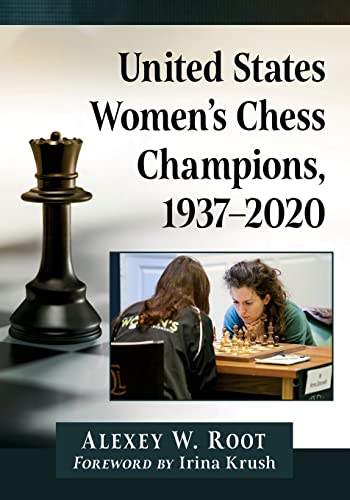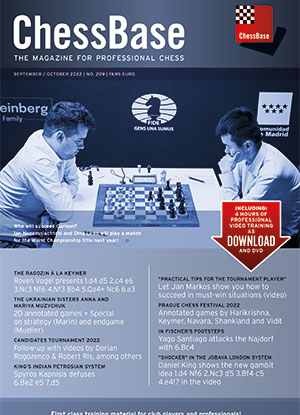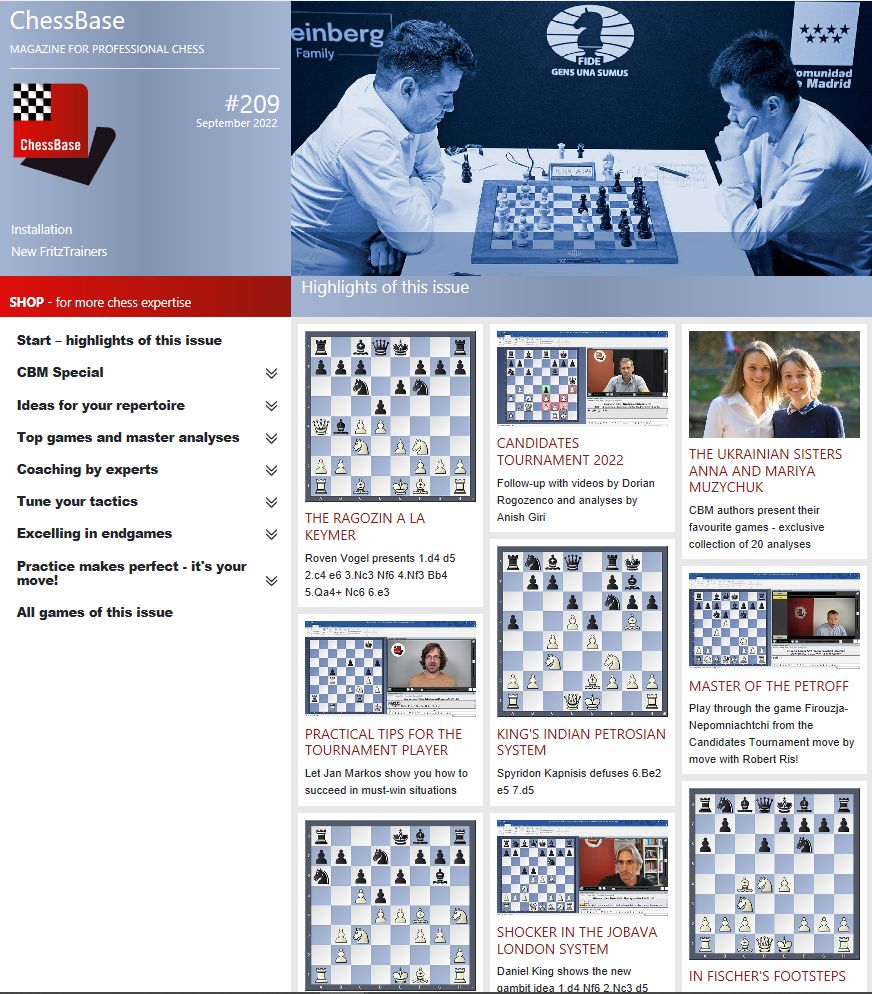CHESSBOOK REVIEWS

Latest book
reviews of 1 October 2022
Wilhelminalaan 33
7261 BP RUURLO
The Netherlands.
John
Elburg
Chess Books

United States Women's
Chess Champions, 1937-2020 (Paperback)
Alexey W. Root
2022
McFarland &
Company,Inc.,Publishers Box 611
Jefferson,North Carolina 28640.
http://www.mcfarlandpub.com
230 pages
Price $49.95
ISBN 10: 1476686939 / ISBN 13:
9781476686936
The former United States Woman's Chess Champion,Alexey W.Root examines
in this wonderful written book the careers with biographies and
games from the 60 Woman championships
which where all held between 1937 and 2020.
The included careers with biographies, plus photographs and 171
annotated games make this book a truly gift, specially with the use of
historical archives and original interviews.
Every heard of Mona May Karff?She was 1938 U.S.Woman's Champion who
learned to play chess at the age of 8 years old,loved opera,collected
art and spoke eights languages fluently,traveld the world round and
made millions in the stock market.
Or Sonja Graf? Her chess career began as a child in her native
Munich,learned chess from her father,and took lessons from the famous
Dr.Siegbert Tarrasch and went to win the Woman's Championship of
Germany.Tarrasch was so impressed by Sonja's combinative talent that he
repeatedly published examples of nice tactics from her games in his
Tarraschs Schachzeitung.
Other famous chess players in this book are for example Irina Krush who
also did an
excellent foreword in this book Jennifer Shade and our author W.Root
who is the former United States Woman's Chess Champion 1989.
The following game won the $250 Albert highest quality game first
prize,as judged by Grandmaster Arthur Bisguier.
Belakovskaia,Anjelina (2355) - Zitserman,Tatyana (2125) [D43]
USA-ch (Women) Chandler (7), 1997
1.d4 d5 2.c4 c6 3.Nc3 Nf6 4.Nf3 e6 5.Bg5 h6 6.Bxf6 Qxf6 7.e3 Nd7 8.Qc2
g6 9.Bd3 Bg7 10.cxd5 cxd5 11.0-0 0-0 12.Rfc1 Qe7 13.Qb3 a6 14.a4 b6
15.Na2 Qd6 16.Qb4 Qb8 17.Rc2 Re8 18.Rac1 Bf8 19.Qb3 Bb7 20.a5 b5 21.Rc7
Rd8 22.h4 Bd6 23.R7c2 Nf6 24.Nb4 Ra7 25.Kf1 Kg7 26.Ke2 Nd7 27.h5 g5
28.Nc6 Bxc6 29.Rxc6 f5 30.Qc2 Rf8 31.Nd2 Nf6 32.Nb3 Nxh5 33.Rb6 Qd8
34.Qc6 Bc7 35.Nc5 Rf6 36.Nxe6+ Rxe6 37.Qxe6 Bxb6 38.axb6 Rb7 39.Rc6 Nf6
40.Bxf5 a5 41.Rd6 Qf8 42.Qc8 Qe7 43.Rc6 Ne8 44.Re6 Qf7 45.Rxe8 Rxb6
46.Rh8 1-0.
Included are nearly 6 pages references, openings index and general
index.
Conclusion: One of those must have
chess books!
Chess DVD's

ChessBase Magazine issue 209
September/October 2022
ChessBase
http://www.chessbase.com
E-Mail
info@chessbase.com
ISSN 1432-8992
Euro 19.95
System requirements:
Minimum: Pentium III 1 GHz, 1 GB RAM, Windows Vista, XP
(Service Pack 3), DirectX9 graphic card with 256 MB RAM, DVD-ROM drive,
Windows Media Player 9, ChessBase 12/Fritz 13 or included Reader and
internet connection for program activation. Recommended: PC Intel Core
i7, 2.8 GHz, 4 GB RAM, Windows 8.1 or Windows 10, DirectX10 graphic
card (or compatible) with 512 MB RAM or better
The main file on this ChessBase Magazine is good for 270 entries, and
where a small 13 games are more than excellent analysed.
A fine example of this all is: Giri,Anish (2761) - Radjabov,Teimour
(2753) [C54]
Norway Chess 10th Stavanger (5), 05.06.2022
[Giri, Anish]
1.e4 e5 2.Nf3 Nc6 3.Bb5 Nf6 Teimour stays true to the ever solid Berlin
defense. 4.d3 Bc5 5.c3 I suspect this came as a minor surprise, since I
usually go for other Anti-Berlins. 5...d6 Somewhat shockingly, my
opponent mixes up the move order as early as move 5. The traditional
order is 5...0-0 6.0-0 d6, but I guess Teimour suddenly got confused
with 6.Bxc6!? bxc6 7.Nxe5, which is a testing line, but Black is
supposed to be fine in complications after 7...d5. 6.d4!? Fortunately I
had refreshed my move orders before the game, as incidentally the day
before I mixed up my own against Carlsen (in a different opening, but
still). The 6.d4 is the "punisher", though objectively Black is not
really in any serious trouble yet. 6...exd4 Black has to give up the
center. The fact that this only move took Teimour quite a bit of time,
only confirmed that he indeed mixed up the order. 7.cxd4 Bb4+ 8.Bd2 The
right way to play for advantage, though 8.Kf1!? looks super tempting,
trying to win material. [8.Kf1!? When I had re-checked this before the
game, I concluded that Black is fine by force. 8...d5! Only move. 9.e5
Ne4 10.Qa4 White still appears to be winning some material, but Black
has a few way to organize counterplay, due to White's weakened king on
f1. One instructive sample line goes- 10...a5 11.Bxc6+ bxc6 12.Qxc6+
Qd7! 13.Qxa8 Qb5+ 14.Kg1 0-0 15.h3 Bb7 16.Qa7 Ra8 17.Na3 Qe2! 18.Qxb7
Qxf2+ 19.Kh2 Qg3+ With a perpetual check. All theory, as they say.]
8...Bxd2+?! While 5...d6 is merely somewhat inaccurate, the decision to
not allow the doubling of the c-pawns is already a serious mistake.
Having given up the center already, Black is not in the position to
prevent abstract threats like Bxc6 and should try to create counterplay
quickly, in order to compensate for the strategic issues, such as lack
of space in the center and potentially doubled pawns. [8...0-0 9.Bxc6
Bxd2+ 10.Nbxd2 bxc6 11.0-0 This is the critical position, where Black
has to act fast, to try to come up with some counterplay before White
gets to fully consolidate their center.] 9.Nbxd2 Bd7?! Besides that it
loses a crucial tempo, it is also the fact that the doubling of the
pawns, as bad as it is, trades a piece, which is a big relief for
Black, as he lacks space. So I am not sure he should fear it much.
10.0-0 0-0 11.Re1 This move is obvious. 11...Re8 12.h3 I decided to
prevent any Bg4 ideas, but developing the other rook with 12.Rc1 would
have been more rough. [12.Rc1! a6 13.Bd3 I may have underestimated this
retreat, but it is a good square for the bishop, guarding the e4 pawn.
13...Bg4 This is not an issue now. 14.Qb3 White has the pawns in the
center well guarded and the queen will soon step over to c3,
overprotecting the d4 pawn as well.] 12...Ne7 Transferring the knight
to g6 doesn't solve the problems. 13.Bf1 c6?! This felt very wrong.
Black isn't generating counterplay, but is weakening the d6 pawn.
14.Qb3!? Highly sophisticated. I felt that 14.e5 would sell my
advantage too short, but actually it was simple and strong. [14.e5 dxe5
15.dxe5 Nfd5 16.Ne4 Nf5 I wasn't sure how much this was, as 17.g4 Nh4
kind of works out for Black. The position is just really good here
though, as White can slowly mobilize and bring the a1 rook into play as
well, before starting some concrete action. Black active looking
knights have no promising jumps here.] 14...Qb6?! I was very surprised
to see this move, giving me Qa3 for free, but Teimour had an issue that
he couldn't solve after the more natural 14...Qc7. [14...Qc7 15.Ng5 Rf8
I was trying to make e5 work here, but Teimour told me that 16.f4!?
scared him away, and indeed it is a very cool idea. 16.f4!? (16.e5 dxe5
17.dxe5 Nfd5) 16...h6 17.Ngf3 idea being 17...d5 (17...Nh5 18.f5) 18.e5
Nh5 19.f5! and capturing the pawn, loses to 20.g4!.] 15.Qa3! Eyeing the
d6 pawn. 15...Qc7 [15...d5 16.e5 Nh5 is not a solution to the problem.
17.g3 Cuts out the h5 knight.] 16.Nc4 Nc8 17.e5! With the knight so
passive on c8, this operation felt well timed. 17...dxe5 18.dxe5 Nd5 I
thought of some concrete ideas related to 19.Ng5, but eventually
realized that White just has to strengthen the position. 19.Rac1 Also
strong was 19.Rad1. 19...h6 20.b4!? I really liked this idea,
preventing b5 and c5 once and for all. [20.Nd4! Got intuitively
dismissed on the account of b5 as well as c5, but it just works by
force. 20...b5 (20...c5 21.Qf3! Is a powerful intermezzo. 21...Ndb6
Here there are many good moves, but my engine's first choice is
incredible. 22.a4! I will see myself out. 22...Nxa4 23.Bd3! cxd4
24.Nd6!) 21.e6! Freeing the e5 square for the knight, with an
overwhelming advantage, once the c6 pawn falls.] 20...Qd8?! Black spent
a lot of time on this move and after thinking along for a while, I
realized that 20...Ndb6! is the best chance, trying to get rid of my
annoying c4 knight and potentially free the knight on c8 from the
defense of the d6 square. Teimour's move is more passive. [20...Ndb6!
White has plenty of options here, but it's hard to say which one is the
best. Black can keep struggling on here.] 21.Qb2! Now my play is
extremely easy. 21...Rb8 22.a3! Black doesn't want anything, so I can
just afford to optimize my position. Interestingly, this move is also
the engine's top choice, which goes to show that simple human logic can
sometimes almost as if by accident match the all-knowing AI. 22...a6
23.Rcd1 Rook is slightly better placed here. 23...Qc7 Here it's time to
go for the final push. 24.Qd4 I couldn't choose between this and Bd3,
with the same idea, to setup a battery along the b1-h7 diagonal, which
would be the final improvement of my pieces, when Black's position
would crack. [24.Bd3! is even cleaner, as in the game there is still a
bit of work left to do.] 24...Bf5 Black fights for the b1-h7 diagonal,
but for this I prepared a simple response. 25.Nh4 Bh7 26.Bd3! Trading
away a defender and introducing the idea of Rd3-Rg3. Black was already
busted for a while, but now he is finally facing concrete problems.
26...b5 This pushes the c4 knight away, but at a high cost. The c6 pawn
is now hopelessly backward and weak. 27.Bxh7+ Kxh7 28.Na5! Nce7 29.Rc1
I decided to just collect the c6 pawn, but there were prettier roads to
victory. [29.e6! was a good one, making Black choose between different
options, all of which are quite unacceptable.] 29...Rbd8 30.Qe4+ Kh8
31.Nf3 I decided to go for the c6 pawn and there was no changing my
mind at this point. [31.Nb3!? Aiming for domination with Nc5 and
eventual f4-f5 was also a way to convert.] 31...Qd7 32.Rc2 I thought
this was accurate, as 32.Nd4 seemed to fail to 32...Nxb4, but in fact
33.e6! wins for White. 32...Ng6 Black tries to give up the doomed pawn
and seek some active play, but one knight on f4 is not going to give
White much headache. [32...Rc8 Defending passively not going to save
the game either. 33.Rec1 Nb6 34.Rd2 Ned5 35.Nd4 Ne7 36.Kh2 Black is out
of moves and White will eventually f4-f5 Black to suffocation.] 33.Nxc6
I just take the pawn. 33...Rc8 34.Rec1 Ngf4 35.Ncd4 Now I just go back.
There is no compensation for the pawn. 35...Rxc2 36.Rxc2 f6 White is
fully mobilized and ready for this attempt to stir up some drama in the
center. 37.Rc5! fxe5 38.Nxe5 Black is the one losing material here,
despite him being the one with a pin. 38...Nc3 39.Rxc3 Qxd4 40.Nf7+ An
intermezzo that seals the game. Black resigned, losing material on the
board, but also running out of time. 1-0.
Other contributions are, Video files: Daniel King: Jobava London System
1.d4 Nf6 2.Nc3 d5 3.Bf4 c5 4.e4!?
Mihail Marin: English
1.c4 e5 2.g3 c6 3.Nf3 e4 4.Nd4 d5 5. cxd5 Qxd5 6.Nc2 Nf6 7.Nc3 Qe5
Ivan Sokolov: QG Ragozin Variation 8...h5 (II)
1.d4 d5 2.c4 e6 3.Nc3 Nf6 4.cxd5 exd5 5.Bg5 Bb46.e3 h6 7.Bh4 g5 8.Bg3
h5 9.h4

Opening surveys: Evgeny Postny: English Four Knights 4.e4 Bb4 5.d3 d6
Petra Papp: Trompowsky 1.d4 Nf6 2.Bg5 c5 3.d5 Ne4
Martin Lorenzini: Scandinavian 3...Qa5 4.d4 Nf6 5.Nf3
Alexey Kuzmin: Sic. Moscow Variation 3.Bb5+ Nd7 4.d4
Yago Santiago: Sic. Najdorf Variation 6.Bc4 e6 7.0-0
Krisztian Szabo: Centre Game 3.Qxd4 Nc6 4.Qe3 Nf6 5.Nc3
Sergei Grigoriants: Spanish 3...a6 4.Ba4 Nge7 5.0-0 Ng6
Roven Vogel: QG Ragozin Variation 5.Qa4+ Nc6 6.e3
Christian Braun: Gruenfeld Fianchetto 5.Nf3 Nc6 6.Nc3 d5
Andrey Sumets: Catalan 8.a4 Nc6 9.Qxc4 Na5 10.Qc2
Spyridon Kapnisis: King's Indian Petrosian Variation.
Other columns are:Special with Anna and Mriya Muzychuk,Ris Move by
Move,All in one,The classic,Reeh Queen sacrifices of all kind,Mueller
Endgame highlights from Prague,Knaak Opening traps and more.
Included is eye catching booklet in two languages plus 4 hours extra
video download!
Conclusion: Smashing material!


